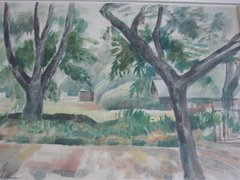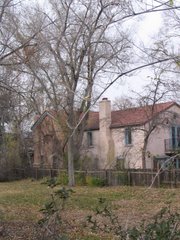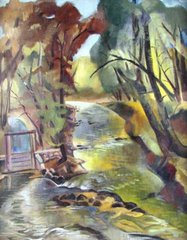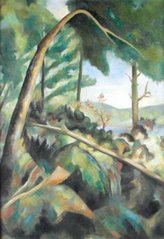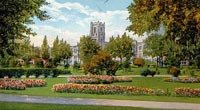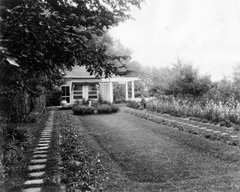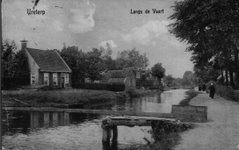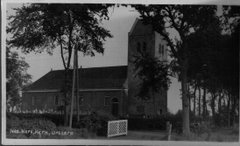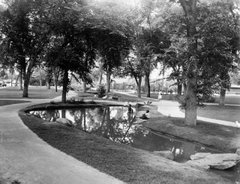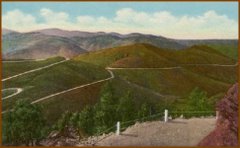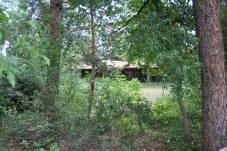A: The DeBoer Park neighborhood is unanimous in its support of the proposed historic district and has been helping to enlist additional friends and neighbors in supporting this landmark proposal. The neighbors also uniformly oppose the efforts of the Potts to essentially scavenge their inheritance by selling off the historic homes and landscaping to a developer that will scrape the homes and eliminate most, if not all, of the trees.
Q: Are neighbors opposed to all development?
A: No. What the neighbors oppose is destruction of the historic buildings on the parcel and development that would be far denser than exists on any other parcel in this neighborhood. The Trust is representing this property to potential buyers as bare land, and assure potential buyers that the city would allow 17-units on a space that now contains just 4 living units. Such development would destroy all open space, erase all historic structures and landscaping, and diminish the property values of the rest of the neighborhood by a combined value in excess of $1 million.
Q: What about private property rights?
A: We are strong defenders of private property rights. But exercising one person's property rights should not come at the expense of an entire neighborhood's property rights. If the Potts (or a developer they sell to) are allowed to demolish the historic structures and clear cut the established forest, this destruction will seriously erode the neighborhood's quality of life and will significantly reduce the property values of the neighbors who bought and live in this area solely because of the historic association with DeBoer and Thompson, the self-sustaining forest and the unique cul-de-sac of Pinon Court.
Restrictions on land use, including laws for zoning restricting the use of property and historic preservation, have been upheld since 1926 by the U.S. Supreme Court as a valid exercise of the city’s power to regulate the safety, health and welfare of communities. As noted in a recent article by the National Trust for Historic Places, constitutional rights are duly preserved in historic designation.
Q: Would historic designation prohibit development or sale of the property?
A: No. The historic designation statute preserves irreplaceable structures, permitting both the sale of the property and compatible development on the property. Landmarking designation is actually less restrictive than changing the zoning of the property, which was one alternative that the neighborhood considered. The Potts have been free to sell the property at any time in this process and have turned down more than one offer, including a cash offer of $1.65 million early in this process.
Q: Is the Tudor the most historically significant building on the property?
A: It is only one of several historically significant structures. DeBoer's home is owned by Ana Novas, one of the applicants for historic designation. DeBoer lived in the house for over half a century, originally a tiny farmhouse dating back to the original homesteader in the 1870's. When DeBoer bought the home in the early 20's, he had to engage in a lengthy process of remodelling and enlarging the home so it would be fit for his family. Most of those additions and renovations made by DeBoer exist to this day, including the original Dutch tiles that DeBoer imported from his native Holland that line the fireplace of the Novas home.
The Tudor is the best known structure in the proposed historic district because DeBoer built it in the 1920's as the site of his landscaping architecture and city planning business. The distinctive tower was DeBoer's own creation, patterned after the tower in his hometown of Ureterp, The Netherlands. That tower exists to this day and is the feature most often remembered by both residents and visitors to the area. DeBoer used the tower as his logo for his business and his personal trademark, including it on his official stationery.
The mural studio of John Edward Thompson, known as the dean of Colorado painters, is also a very important structure in the District. The building was designed by the noted architectural firm, Fisher & Fisher; Arthur Fisher was a contemporary and colleague of both DeBoer and Thompson. Thompson started the University of Denver’s School of Art and introduced impressionism to the West.
Q: Is this a hostile designation?
A: No. The proposed historic district includes five lots owned by three owners. Two of owners support designation; one is against. This cannot be called a hostile nomination. A more proper term would be a "mixed" district. In fact, most historic districts in Denver are similarly mixed. Rare indeed is the district in which every property owner supports historic designation.
Q: Were the Potts prejudiced in any way by not having prior notice of the landmarking application before it was filed?
A: No. At the time of the application, the Potts already had development proposals to tear down the structures and were attempting to keep the neighborhood in the dark about their plan.
For the past year, the Potts' have had two separate law firms presenting their ever-shifting arguments opposing the application. They have not been prejudiced by the Applicant’s protective action to forestall demolition. In fact, the use of this issue and the portrayal of the Potts as victims in the massive public relations campaign is simply a red herring, designed to misinform the public and take attention away from what’s really at stake.
It is ironic for the Potts to claim harm from not being informed of the landmark application when they themselves sold the property in secret to a developer who intended to demolish most if not all of the structures and eliminate the trees before the neighborhood got wind of it.
A: Yes, that's true. In 2004, the Potts trapped and gassed an entire family of foxes who had lived in the area for years. It was a minor cause celebre at the time, and even hit the local papers. It was an unfortunate chapter in the history of the DeBoer district and gave the neighborhood a preview of the Potts’ mantra, “my way or the highway.”
Q: Why doesn’t the neighborhood buy the property?
A: A full price offer of $1.9 million was turned down by the Potts last summer. This offer required a longer closing period to enable the neighbors to obtain historic preservation grants. Not only did the Potts reject the offer outright, they raised the asking price, to these buyers only, to $2.2 million.
Q: Did landmark designation scare away a potential buyer?
A: No. The potential buyer, McStain Neighborhoods, has authorized the applicants to state for the record that this contract was terminated for reasons other than the landmark application.
Q: What would DeBoer do?
A: We invite you to read his words, look at the trees he planted, consider his determined efforts over more than 50 years on this site, and ask yourself the same question.

